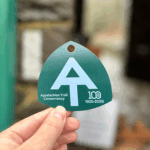What is Thru & Section Hiking?
Thru-hiking the Appalachian Trail
Thru-hikers complete the A.T. in 12 months or less, with most thru-hikes taking around 6 months. Thru-hiking is physically and mentally demanding, with only about 1 in every 3 thru-hikers completing the journey. However, many thru-hikers rank their hike as one of the greatest accomplishments of their life and carry their memories of the Trail with them forever. The ATC recognizes thru-hikes regardless of sequence or whether or not you carried a pack (and in fact, we recommend flip flop hikes as a way to reduce overcrowding on the Trail!). All successful thru-hikers are eligible for the ATC’s 2,000-miler program.
Section Hiking the Appalachian Trail
A section hiker completes the A.T. over a period of more than 12 months, with many taking years to complete the Trail. This method allows hikers to enjoy all the A.T. has to offer without making some of the sacrifices required for a thru-hike. All section hikers who complete the A.T. are eligible for ATC’s 2,000-miler program, no matter how long it takes!
Thru-Hiker FAQsWhere to Start
NOBO
The most popular way to hike the A.T., but also the most crowded from mid February to mid April. Expect cold early on and heat in the summer. Hikers should plan to arrive at Katahdin before October 15.
NorthboundFlip Flop
Flip-Flop hikes begin somewhere in the middle of the Trail for a flexible and less crowded itinerary. Enjoy milder weather, easier terrain early on, and more frequent resupplies while helping reduce overcrowding.
Flip FlopSOBO
Starting at Katahdin means beginning with one of the toughest sections of the Trail. The remote, rugged terrain in Maine is challenging, with fewer resupply points early on, so this route is best for experienced and fit hikers.
SouthboundQuick Tip
Know Your Limits
Although you may tackle the A.T. in any order you wish, New Hampshire and Maine are more rugged and challenging than other parts of the Trail, with steep, rocky, root-covered, and muddy terrain that can be difficult for both beginners and veteran hikers planning their Appalachian Trail itinerary.
Plan & Prepare
What to Carry
The most predictable mistake hikers make when they start is carrying too much stuff. Learn about the 10 Essentials and how to trim pack weight while carrying what you need.
What to CarryMaps & Guides
Thru-hiking guides and planners, official A.T. maps, and more are available in our Trail Store.
ATC Trail StoreSafety on the Trail
Learn about the hazards you may face when hiking the Appalachian Trail and how to best prepare for a safe, healthy hike.
SafetyTrail Updates
Know before you go — be aware of the latest Appalachian Trail conditions, weather advisories, and reroutes/closures.
Trail UpdatesResponsible Recreation
Camping & Shelters
Whether you’re pitching a tent or staying at one of the 250+ backcountry shelters along the Trail, it’s important to follow regulations and minimize your impact on the environment.
Camping & SheltersPermits & Fees
Some parts of the Trail require an entrance fee and permit, and some places require fees for camping.
Permits & FeesThe A.T. Ethic: Hiking Sustainably




Report an Incident
While the Appalachian Trail is a relatively safe place to visit, that does not mean that there are not potential dangers while you are hiking or camping. If you see something, say something — this will help us keep the A.T. as safe as possible for our visitors.
Report an IncidentRegistering & Finishing Your Hike

ATCamp Registration
Thru-hikers can voluntarily register their hikes at ATCamp to connect with fellow hikers, share their planned start date, and help protect the Trail from overcrowding.

A.T. Hangtags
Hangtags distributed by the Appalachian Trail Conservancy are frequently seen dangling off an aspiring 2,000-miler’s pack, marking their intent to traverse the entire Appalachian Trail.
About A.T. Hangtags
Finish Well at Baxter State Park
Celebrate the history and significance of Katahdin and your thru-hike by following these guidelines while hiking to the northern terminus of the Appalachian Trail. If you are supporting an A.T. hiker, learn how to do so before, during, and after their journey with tips on safety, communication, resupply logistics, and more.
Report a Successful Hike of the Entire Appalachian Trail
Section hikers and thru-hikers who complete the entire A.T. can report their journeys to us by filling out the 2,000-miler application. Those who submit their applications will be added to our roster of 2,000-milers and will receive a certificate of recognition, an A.T. patch, an accompanying 2,000-miler “rocker” patch, and be featured in the Spring issue of A.T. Journeys magazine.
About 2,000 Miler Applications





